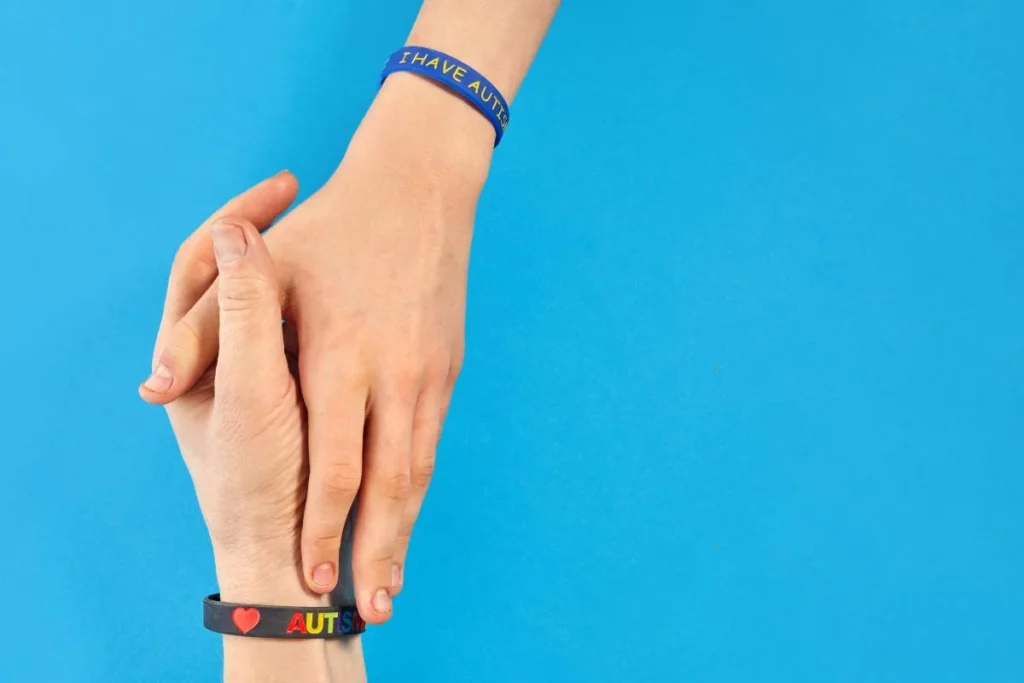Technology can provide many benefits for people with autism spectrum disorder (ASD). With the right tools and support, technology has the power to enhance communication, provide structure, allow self-expression, and more.
One of the biggest challenges many people with ASD face is difficulty with communication skills. Apps and devices that use pictures, sounds, and text can help augment their ability to understand others and express their thoughts and feelings. Technology like speech-generating devices gives a voice to nonverbal individuals. Communication boards, social stories, and visual schedules foster interaction through images. These tools pave the way for social connection.
Technology can be designed to provide routines and structure that many people with ASD thrive on. Visual schedules and timers on tablets or computers allow individuals to transition between tasks and activities with minimal anxiety. Educational games and apps provide positive reinforcement and repetition within a predictable system. All of this promotes self-regulation and independence.
Technology opens up avenues for self-expression and creativity. Drawing apps, music tools, and video creation software allow people with ASD to communicate their passions, thoughts, and talents. This boosts self-esteem and quality of life. Technology gives them an outlet to shine.
Communication Apps
Communication is one of the main challenges for people with autism. Apps that utilize pictures, visual schedules, and text-to-speech can help improve communication skills.
Visual Schedules
Visual schedules use images and icons to break down activities and routines into steps. Seeing a sequence of events laid out visually can help reduce anxiety around transitions and improve independence. Some popular visual schedule apps include First/Then Visual Schedule, Choiceworks, and Visual Schedule Planner. These apps allow caregivers to create customizable schedules with photographs or clipart.
Picture Exchange Apps
Picture exchange communication systems (PECS) involve sharing pictures to communicate wants and needs. This can help nonverbal individuals on the spectrum convey messages. Apps like Proloquo2Go, LAMP Words for Life, and Avaz provide libraries of symbols and images that can be put together to form sentences. The user selects images on the tablet to create phrases.
Text-to-Speech Apps
Text-to-speech apps allow people with limited verbal ability to type what they want to say and have it spoken aloud. Options like Voice4u and Verbally app offer text-to-speech with word prediction and saved phrases to speed up communication. These tools give a voice to those who struggle with speech.
Technology will continue to revolutionize communication for people with autism. Visual aids, picture exchange, and text-to-speech provide effective alternatives to traditional verbal communication. These tools empower individuals on the spectrum to better express their wants, needs, thoughts, and feelings.
Social Skills Apps
Social skills apps can provide engaging and interactive ways for autistic individuals to learn and practice social skills. These apps often use game elements, videos, and virtual reality to teach critical skills like interpreting emotions, handling social situations, and communicating effectively.
One common use of apps is for emotion recognition games. These games display faces showing different emotions and have users identify the emotion. Some examples are Let’s Face It!, Face Say, and Emotion Mirror. Going through different exercises and getting feedback helps autistic users better recognize facial expressions and emotions in real life.
Conversation prompts and script apps are another helpful category. Apps like FirstThen Visual Schedule, Autism & Beyond, and MyTalkTools provide scripts and step-by-step guides for conversations and social situations. Users can learn appropriate ways to interact in contexts like introductions, asking for help, or apologizing. The scripts act as training wheels for handling social exchanges more independently.
Virtual reality (VR) is also increasingly being used. VR headsets allow users to be immersed in simulated social environments and practice skills. For example, Floreo teaches social rules through VR games and scenarios. The user controls an avatar and navigates through conversations with other characters. This safe space prepares them for real-world interactions. As VR technology improves, it may become even more beneficial for developing social competence.
Focus and Calming Apps
Many individuals with autism struggle with sensory sensitivity, anxiety, and maintaining focus. Apps and devices that help create structure, block excess stimuli, and provide calming feedback can make a major difference in helping autistic people self-regulate.
Popular options include:
Noise-canceling headphones – These headphones block background sounds that can be distracting or overwhelming. They are useful in loud environments like schools, malls, or crowded events. Quality noise-canceling headphones tailored for those with sensory issues can help autistic people participate more fully in activities.
Fidget and sensory tools – Fidget toys provide tactile stimulation that can help autistic individuals channel excess energy and anxiety. Simple tools like fidget spinners and squishy stress balls allow autistic people to focus by occupying their hands. Virtual fidget apps offer digital alternatives.
Timers and visual schedules – Visual timers show the passage of time, while visual schedules display activities in picture format. These tools provide structure and predictability for autistic individuals who benefit from routine. Knowing what to expect can curb anxiety and allow better focus on tasks. Timers also help with time management.
The right tools to minimize distractions, sensory overload, and uncertainty can make a big difference in an autistic person’s ability to calm themselves, maintain focus, and engage positively with the world around them. Tech innovations continue to provide more options to support sensory needs and self-regulation.
Learning and Education Apps
Apps that focus on reading, math, vocabulary, and interactive learning can be incredibly helpful for children with autism. These types of apps allow kids to practice important academic and cognitive skills in an engaging, gamified way. Some popular autism learning apps include:
Reading Apps
-
ABC Mouse – Comprehensive learning program covering reading, math, science, and more through interactive books, songs, puzzles, and games.
-
Starfall Learn to Read – Fun phonics-based app to build early reading skills. Uses songs, stories, and games.
-
Reading Raven – Colorful reading program with phonics, sight words, and reading comprehension.
Math Apps
-
Bedtime Math – Makes math engaging through fun word problems and math stories.
-
DragonBox – Teaches early math concepts like geometry, fractions, and algebra through puzzle gameplay.
-
MathBuddy – Covers counting, shapes, addition, subtraction, and more with talking avatars.
Vocabulary Apps
-
Word Magic – Talking vocab app with word searches, matching games, and flashcards.
-
Anagram Magic – Scrambled word puzzles to build phonics and spelling skills.
-
Core Word Classroom – Vocab builder focused on building functional communication skills.
Interactive Learning
-
ABA DrOmnibus – Reinforces ABA techniques through interactive games and videos.
-
Language Express – Speech therapy app covering social skills, conversation, and emotions.
-
Proloquo2Go – Augmentative communication app with text-to-speech and symbol-based interaction.
These educational apps provide engaging, interactive ways for autistic kids to build critical academic, cognitive, and communication skills through technology.
Life Skills Apps
Life skills are essential for people with autism to gain independence. Apps that provide support for daily living activities can be hugely beneficial. Some key features of life skills apps include:
Visual Recipes and Schedules
Picture-based recipes and visual schedules allow autistic individuals to follow routines more easily. Step-by-step instructions paired with images help reduce anxiety around daily tasks. Popular apps provide customizable recipe templates and scheduling boards to match each person’s needs.
Interactive Chores and Routines
Apps that gamify chores and routines with rewards and praise can motivate autistic users. Interactive checklists, timers, and prompts guide users through each task. Built-in praise and celebrations reinforce positive behaviors. These apps tap into special interests to make chores and routines more engaging.
Personal Hygiene Tutorials
Mastering personal hygiene and self-care skills is essential for independence. Video modeling apps provide customizable tutorials that break down grooming tasks into step-by-step instructions. Users can learn at their own pace with visual supports. Some apps also include schedules, checklists, and rewards to reinforce learning. These apps aim to build confidence and autonomy around hygiene routines.
Therapy and Intervention Apps
Apps that provide therapy and intervention for autism have become extremely popular and helpful. Many apps are designed around the principles of Applied Behavior Analysis (ABA) and allow parents and therapists to run ABA programs from a tablet or phone. These apps can present lessons, record data, and track progress over time. Some popular ABA apps include ABA Wizard, ABA Toolkit, AutisMate, and several others. These apps help implement ABA techniques in a fun, engaging way through the tablet.
Speech therapy apps are also very common for autism. These apps allow children to practice speech sounds, grammar, conversation skills, and more in an interactive format. Some examples are Articulation Station, Conversation Builder, and Language Express. Parents and speech therapists can use these apps to supplement face-to-face therapy.
Many data tracking and assessment apps allow parents and teachers to collect information on behaviors, skills, and progress. Apps like Catalyst, Skills, and DataChat make it easy to record notes, take videos, and generate reports. This data helps monitor development over time and identify strengths and weaknesses to target.
Assistive Technology Devices
Assistive technology can be incredibly helpful for people with autism. Some of the most useful assistive devices include:
Alternative Keyboards
Alternative keyboards allow users to type in ways that are easier for them. Options include keyboards with larger or spaced-out keys, keyboards that predict words as the user types, and keyboards that speak each letter aloud. These can help individuals who struggle with fine motor skills or processing written language.
Screen Readers and Text Enlargement
Screen readers read digital text aloud for those who have difficulty reading. They are usually used along with text enlargement, which increases the text size on screens. Both allow people who are visually impaired or struggle with reading to access digital content.
Speech Recognition Devices
Speech recognition software transcribes speech into text. This enables people who have challenges with writing and typing to dictate words and compose text using their voice instead. Speech recognition can be extremely empowering for people who have motor difficulties.
Assistive technology removes barriers for people with disabilities and allows them to communicate, learn, work, and complete tasks more independently. For individuals with autism, these devices can improve their quality of life tremendously.
The Future of Autism Tech
Technology is rapidly advancing, presenting exciting opportunities to empower and support autistic individuals. Here are some key areas to watch in the future of autism technology:
AI and Machine Learning
Artificial intelligence and machine learning have huge potential for autism. AI can analyze behavioral patterns and customize supports and interventions for each individual. Machine learning algorithms can also improve speech recognition for communication devices. As the technology develops, AI assistants may help coach social skills, model appropriate behavior, and provide feedback.
Virtual and Augmented Reality
Immersive technologies like virtual and augmented reality create safe spaces to practice skills. VR can simulate social situations to rehearse appropriate responses without real-world consequences. AR glasses can overlay visual cues, reminders, and instructions onto the physical environment to assist with daily living. These technologies allow autistic people to practice life skills and social interactions in an engaging, repetitive, and low-risk setting.
Empowering Autonomy and Independence
Future autism technologies aim to empower people to live independently. Smart home devices can provide reminders and alerts for daily tasks. GPS trackers and wearables allow caregivers to discreetly monitor individuals venturing outdoors alone. Robotics and AI assistants can aid with social functioning, communication, education, and therapy. The goal is to develop customizable technologies that enhance quality of life and greater autonomy.
The future looks bright for innovative autism technologies that can personalized support needs, empower people, and improve life skills. With rapid advancements in AI, VR, robotics, and more, there are endless possibilities to help address the diverse challenges of autism. The key will be developing ethical, accessible, and human-centric technologies that focus on abilities, not just disabilities.
Sponsored by our partners, discover a range of Patek Philippe Replica watches online, from affordable options to premium Super Clone models.







